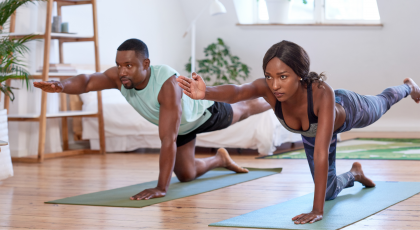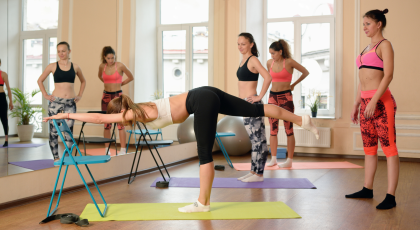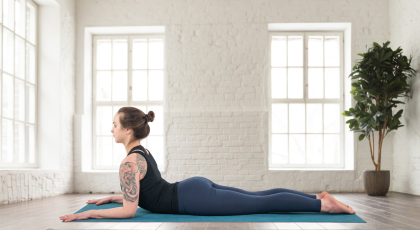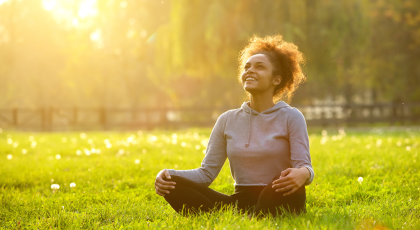View basket (0 items $0.00)

Baby Backbends: Yoga's Quiet Powerhouse Poses
You won’t see them on Instagram. There are so many other backbends that look way more impressive on a sunset-drenched beach. In fact, they may barely register as backbends when you look at the outer form. Indeed, they are called “baby” backbends, suggesting lesser poses reserved for people who can’t do the “real” backbends. And yet, after 38 years of yoga practice, I’ve developed a renewed appreciation for these power-packed poses.
In 2016, I had my first bone density scan. While I had no reason to think my bones might be at risk—my mother touted her strong bones well into her 80s—my doctor recommended it as a matter of course.
Much to my surprise and disappointment, the results showed osteopenia in my lumbar spine. My doctor recommended bone-building drugs but was open to my desire to try a more targeted calcium supplement and to change my exercise program. In late 2019, I had another bone scan. This time the scan showed significant improvement.
I can’t attribute my improvement to just one thing. I’ve faithfully taken daily calcium and have brought my vitamin D3 up to a healthy level. (My D3 levels were quite low at the time of my first bone scan.) In addition, I started weekly strength training 18 months ago. And I’ve begun practicing a whole lot more baby backbends.
Strengthening the Entire Core
Most of the time, when we think of stabilizing the core, abdominal strengthening comes to mind. While weak abdominals do contribute to back pain and postural problems, abdominal strengthening is only half of the equation. Weak back muscles contribute equally to these issues.
Think about it. We spend a whole lot of our time sitting. When we sit and hunch over a keyboard, every joint is in a flexed position—the spine, the shoulders, the hips, the knees, and the ankles. This can cause the flexors—including the abdominal muscles—to shorten, and the extensors—including the back muscles—to become slack. As the flexors shorten and the extensors lengthen, we become a whole lot more likely to assume a flexed posture even when we are not sitting. (FYI: in terms of the spine, “flexion” means forward bending, and “extension” means backbending.)
Over time, gravity conspires with the force of habit to cause the spine to become fixed in a forward flexed position. The spinal extensors, the muscles that help us maintain an upright spine, continue to weaken and can no longer do their job of keeping the spine vertical.
The solution? Strengthen the spinal extensors, specifically the erector spinae. The name tells you all you need to know: when these muscles contract, they keep the spine erect. The spinal extensors not only help you maintain upright posture; the pressure of these muscles squeezing in on the spine also helps strengthen the vertebrae.

Baby Backbends for Strong Bones and Upright Posture
In my experience, the yoga poses that are most supportive of strengthening the spinal extensors are the baby backbends. These powerful poses are mostly practiced in a prone position. They include poses such as Salabhasana (Locust Pose), Bhujangasana (Cobra Pose), and Ardha Bhujangasana (Half Cobra Pose). Setu Bandha Sarvangasana (Bridge Pose) can also reside in the baby backbend category, even though it’s initiated from a supine position. Most of all, baby backbends are poses that employ the spinal extensors—either exclusively or with some support from the limbs—to gently but powerfully extend the spine.
My number one pick for spine-strengthening, posture-supporting baby backbends are the many variations of Salabhasana. What makes these poses especially powerful is that they employ the back muscles exclusively to extend the spine. In Cobra Pose, Bridge Pose, and the other backbending yoga poses, the arms and legs support spinal extension, sometimes so much so that the back muscles carry less of the load.
For some practitioners, especially those whose thoracic spines are already hyper-kyphotic (bent forward), lifting the spine off the floor without using the arms will be difficult to impossible. For these practitioners, and those with significant scoliosis (lateral curves), Half Cobra Pose, and/or Cobra Pose with light support from the arms and hands, along with Bridge Pose, will be the best choices for strengthening and extending the spine.
How to Practice Salabhasana

For the purpose of this post, I’m going to focus solely on the Salabhasana variations. The different variations focus the work into different parts of the spine, so make sure to practice all of them at least once.
Remember that Cobra or Bridge poses may be more helpful for people with scoliosis or hyper-kyphosis:
-
Gather your props: a yoga mat and a folded blanket.
-
Lie face down on the mat with a folded blanket under your hipbones.
-
Extend your arms alongside your body. Then clasp your fingers behind you, rolling the shoulders up and away from the floor. Stretch your hands back behind you. You can also simply extend the arms behind you, alongside your torso, without clasping the hands.
-
Ground your hips, legs, and feet, and lift your chest, shoulders and head off the floor. Avoid throwing your head back. Instead, keep the back of your neck long, so that your head and neck are following the trajectory of your thoracic spine. You’ll be looking at the floor. Lift your arms up toward the sky.
-
Take 5 to 10 deep breaths. Then release your upper body back onto the mat and rest your forehead in your hands. Breathe into your back, expanding your back on the inhalations, and settling into the floor on your exhalations.
-
Now follow the same instructions and practice these variations:
-
Lift the chest, shoulders, and head with the arms extended straight outward from your shoulders.
-
Return to the fingers-clasped arm position and lift the legs in addition to the upper body.
-
Extend the arms straight outward from your shoulders and lift the legs as well as the upper body.
-
With your upper body on the floor and your arms alongside your body, lift your right leg up, without lifting your right hipbone off the floor. Release and repeat on the left side. Then repeat this movement lifting both legs simultaneously.
Don’t let their diminutive nickname fool you. The baby backbends, along with weight-bearing exercise and proper nutrition, might be your greatest allies in helping you maintain a strong spine and graceful, upright posture. Add these powerhouse poses to your regular yoga practice.
Enjoy more practice tips from YogaUOnline and writer Christine Malossi- 4 Reasons for Back Pain and How Yoga Can Help.

Charlotte Bell began practicing yoga in 1982 and began teaching in 1986. She was certified by B.K.S. Iyengar in 1989 following a trip to Pune. In 1986, she began practicing Insight Meditation with her mentors Pujari and Abhilasha Keays. Her asana classes blend mindfulness with physical movement. Charlotte writes a column for Catalyst Magazine and serves as editor for Yoga U Online. She is the author of two books: Mindful Yoga, Mindful Life and Yoga for Meditators, both published by Rodmell Press. She also edits Hugger Mugger Yoga Products¹ blog and is a founding board member for GreenTREE Yoga, a non-profit that brings yoga to underserved populations. A lifelong musician, she plays oboe and English horn in the Salt Lake Symphony and the folk sextet Red Rock Rondo whose 2010 PBS music special won two Emmys.
Featured Courses









